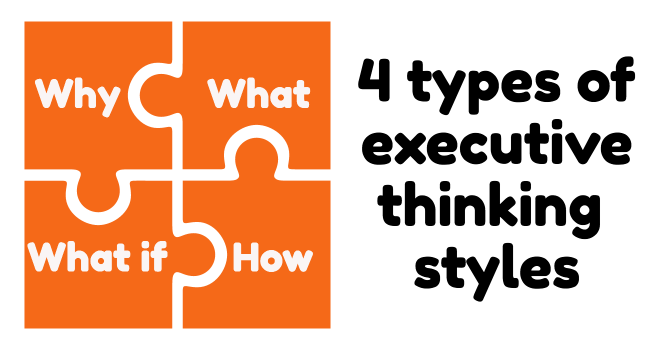Executive presentations can be the hardest nut to crack, yet will have the biggest bang for your buck when it comes to your career advancement.
Master the executive presentation, and you will get the visibility and recognition to drive your career upward. The alternative is to fumble and ramble through, and get labeled as “not for leadership” material.
It’s unfortunate because being smart, analytical, detailed oriented will work against you when developing your executive brief, unless, you follow a disciplined approach to clarify and broaden your message.
What is an executive presentation?
An executive presentation is a brief update or a proposal you deliver to the executives in your organization. You either do an update on a project you worked/ working on, or you make a proposal for something new.
An executive presentation is also called an Executive Brief
It’s called a brief because executives live in a “no time,” “no patience dimension,” and will not tolerate you wasting their time.
I know that you might be thinking – you are busy too and distilling your message to the essence is hard to do, and maybe unfair to expect it out of you, but that’s the reality we live in. The senior executives hold the key to your promotions and making their life easier by putting some thought into your presentation will make your career progress easier.
Demystifying Executive Presentations with the 4 Executive Thinking Styles:
To create excellent executive presentations, you need to understand the 4 executive thinking styles. Then you need to tailor your message to appeal to those thinking styles instead of your own
The four thinking styles of executives is an adaptation of Dr. Bernice McCarthy’s 4MAT learning style system developed for to enhance the educational experience of students. I adopted it over the years to communicate better with leaders and executives in a business setting.
The “Why” thinkers:
The first executive thinking style is called the “Why” thinking style, these are the executives who care mostly about why we are doing things and why now. These executives tend to be in sales, marketing, and a lot of times the CEOs.
The “What” thinkers:
The second executive thinking style is called the “What” thinking style, these are the executives that care mostly about answering “what based questions” like what is the background, what is the science, what is the history, what is the science? Etc. These executives tend to be in engineering and technology like the CTO of companies or the VP of engineering.
These executives tend to be in engineering and technology like the CTO of companies or the VP of engineering.
The “How” thinkers
The third executive thinking style is the “How” thinking style. The how thinking executives, tend to think by asking “How based questions” like how do we get it done, how do we go forward, How do we get over this obstacle? Etc. The COO or the VP of project management would have this style.
The COO or the VP of project management would have this style.
The “What if” thinkers:
The fourth executive thinking style is the “What if” style. This is a funny group because they have “what if negative,” and “what if positive.”
The what if positive thinkers are the entrepreneurial executives like the CEO and co-founders of a startup (CEOs of established companies tend to be Why thinkers for the most part).
The what if negative are the executives that usually focus on what could go wrong like corporate counsel, CFO, and VP of quality. Note- there is nothing wrong with being what if negative, in fact, this type of thinking, is essential for strong organizations.
If you want to create an executive presentation, the safest route is to assume that all these thinking styles are present in the room and create a presentation that addressed all these learning styles.
Warning: if you do not consider all these thinking styles, then you will create a presentation based on your thinking style as a default and as a result, you will resonate with people who think like you and miss the rest.
[easy-tweet tweet=”if you do not consider all these thinking styles, then you will create a presentation based on yours.”]
When you are communicating with your peers, communication-based on your learning style is OK because your peers will probably think like you.
However, as you go higher in your organization, your message must have a broader appeal. Being able to communicate in all four thinking styles will allow you to reach more people and influence more executives with your message.
The 7 Questions to answer in every executive presentation or briefing:
Now that you know the thinking styles, all you have to do is create a presentation based on all these styles. Below is the template to guide you the next time you have to create a brief.
When used, this template will ensure that you have a concise, precise and laser focused executive presentation that will get the eyes of officials to jump out of their sockets.
The 7 questions you need to answer in every brief:
1. Why are you there?
You have to be explicit in front of executives. You can’t be vague and wishy-washy. You got to be upfront with why you are there presenting to them.
Some examples of good answers: I am here today to give you an update on project x, or I am here to propose a new way of doing business.
2. Why does it matter (why is what you are saying important now)?
When executives are making a decision, they are always trying to assess the importance of what you are talking about. You tell them the importance of your idea, proposal, update, to make sure they don’t check out trying to figure it out on their own.
It’s amazing how many executives space out during a technical project update because they have no idea why the project is important anyway.
So you got to tell them why it is important now.
3. What is the background?
If you see 10 project updates a day, then after a week all these projects start to blur in your mind. That’s what happens to executives unless the project is one of their baby projects (a project they are directly involved in).
Most likely they will forget about your project unless you remind them and give them context by giving some background on what you are doing. It is easy to overdo this step, so be careful, and just give some background to establish common ground but not so much to bore and distract the executives with the minutia.
4. What is the update or what is the proposal?
This is the part where you get to the meat of the topic. Everything you said before this step was the ramp up for this.
I know what you might be thinking: don’t the executives want this part only. No, they also want the context and the importance of the update. Otherwise, they will be confused.
5. How to go forward?
This is where you tell the executives the next steps. Again, don’t get too much into the weeds here, talk about next steps in big blocks. You don’t need to tell them the timeline one hour at a time; you just need to explain the next steps from a broader perspective.
Instead of saying today, we will do x, tomorrow we will do y, and so on for an hour. Say we are working on getting manufacturing approval by the end of this month, and we will roll out the change in beta mode by the end of the quarter, and if everything checks out, we will launch with full force in Q3 this year.
Notice, no minutiae, just logical and zoomed out perspective.
6. What if negative
Remember, the what if negative people are the ones who will point out what’s wrong with you presentation. Ideally, you want to handle these people and their objections offline by lobbying their support. However, that might not always happen, so what you want to do here is bring up objections, alternatives and quickly deal with them.
[easy-tweet tweet=”Always try to lobby for support offline before the big presentation. The presentation is just a formality.” hashtags=”leadership, influence, sanfranciscoclasses”]
There are two reasons you bring this up first, rather than wait for someone to bring it up:
- One it shows that you have a balanced and rational view and it shows that you considered alternatives and what could go wrong and adjusted for it.
- Two it allows you to bring up objections first and deal with them before others do. This allows you to handle objections without having the other’s ego attached to it.Imagine if the CFO brings up an objection and you manage it, the CFO’s ego might get touched a bit, and she might dig in her heels, but if you bring up the objection and handle it before the CFO then you save the CFO’s ego, and you might get less resistance from her.
It’s important to remember calibration here – if there are no objections to your ideas, then maybe just mention a couple of alternative plans to show that you are balanced in your thinking, or just skip this altogether. The last thing you want to do is to plant objections when there were none.
7. What if positive
The executives are human beings too. So naturally, they have big goals, big dreams, and big ideas too. These thoughts usually manifest themselves in big company initiatives or executive baby projects. These baby projects tend to occupy a lot of the executive’s mind, and naturally, they care more about these pet projects than your project.
In the “what if positive” section of your executive brief, you want to tie your ideas to one of these baby projects or big company initiatives if you can.
For example: If you know that there is a big business initiative to improve diversity in your organization, and your proposal is related to the new intern rotation program, then at the end link your project to that big company initiative for diversity.
With both the what if negative and what if positive, you don’t want to overdo things. Use both strategically in the right meeting and for the right projects and updates.
Notice that all the above questions address all the executive thinking styles. Answering these questions will make sure that you appeal to all of the executives in the room and demonstrate that you can communicate to a broad audience.
Most of the time answering these questions will be your whole executive presentation.
Step by step procedure:
First, think of a project update or a project proposal you want to present to the executives.
Second, go through the template below and answer one question at a time. Just keep it simple, the executive brief is typically between 2-15 minutes max. If the executives need more, they will ask you questions, but most of the time this is all they need.
Executive Brief Template
You can use this template to create your verbal executive briefing, or you can do it as a physical print out or email to send out to executives. Either way, it will work.
Use the template exactly as it is first, then if you want to adjust things feel free to make adjustments to fit your style and personality.
- Why are you here?
I am here to __________ - Why is it important?
This is important because__________ - What is the background?
Just to give you some background on this:__________ - What is the update or what is the proposal?
– For update: Here is the latest update__________
– For a proposal: Because of__________, I recommend/ propose we do__________ - How to go forward?
The way to go forward for us is__________ - What if negative?
– If objections then use this: I know some of you might be thinking__________, but,__________
– If consequences: If we don’t do__________, then__________
– If presenting alternatives: We also considered__________, and we still think__________ - What if positive?
After all, we are trying to achieve_(Big Initiative)__, and this__(your proposal or update)__will help us do it (faster, better, etc)
Here is an example of an executive presentation/briefing
For this example, I will show you an example, for a project proposal from the biotech industry.
————————
Good morning!
- I am here today to propose a new process for handling deviations.
- This is important because the new process will help us increase efficiency and accuracy.
- Just a quick background, our normal process for handling deviations right now looks like x, y, z (I removed the actual process to keep it simple). As you can tell there are multiple steps in the process, and that takes a lot of time and provides multiple points of error in documentation.
- I want to propose a new process to replace the x, y, z steps with only step w. This reduces the process to one step instead of three. For example…. (you can further illustrate by elaborating with a small example)
- To go forward we just need your approval on this new process for handling deviations, and once we have it, my team and I will take care of the documentation and training, and we will be ready to roll out by next quarter.
- I know that some of you might be concerned that reducing the process to one step instead of three removes the checks and balances that come with many eyes seeing the deviation.We, in fact, believe that reducing to one step, with one centralized accountability will enhance the accuracy. We currently follow a similar one step process for changing SOPs, and since implementation, it reduced the errors in procedures by 30%. We think we will achieve the same effect with this process change to handling deviations.
- After all, our big initiative this year is to improve our manufacturing efficiency, and to update the deviation process is one big step forward to help us achieve our efficiency goal.
___________
Notice when you do the example, you do not vocalize the questions. The questions are just for you to help guide you and keep you organized. Here is the same example above with questions so that you see how they were used.
——-
Good morning!
Why are you here?
I am here to __________
I am here today to propose a new process for handling deviations.
Why is it important?
This is important because ______________
This is important because the new process will help us increase efficiency and accuracy.
What is the background?
Just to give you some background on this:______________
Just a quick background, our normal process for handling deviations right now looks like x, y, z (I removed the actual process to keep it simple). As you can tell there are multiple steps in the process, and that takes a lot of time and provides multiple points of error in documentation.
What is the update or what is the proposal?
For update: Here is the latest update_________________
(NA, it’s a proposal this time, see below)
For a proposal: Because of ______________, I recommend/ propose we do __________________
I want to propose a new process to replace the x, y, z steps with only step w. This reduces the process to one step instead of three. For example….
How to go forward?
The way to go forward for us is __________________________
To go forward we just need your approval on this process, and once we have it, my team and I will take care of the documentation and training, and we will be ready to roll out by next quarter.
What if negative?
If objections then use this: I know some of you might be thinking________, but, ____________________________
I know that some of you might be concerned that reducing the process to one step instead of three removes the checks and balances that come with multiple set of eyes seeing the deviation. We, in fact, believe that reducing to one step, with one centralized accountability will enhance the accuracy.
We currently follow a similar one-step process for changing SOPs and since implemented it reduced the errors in procedures by 30%. We think we will achieve the same effect with this process change to handling deviations.
If consequences: If we don’t do _____________, then ___________
NA handled objection this time
If presenting alternatives: We also considered _______________, and we still think____________________________
NA handled objections this time
What if positive?
After all we are trying to achieve ___(big initiative)___________, and this ____(update/proposal)____________ will help us do it (faster, better, etc)
After all, our big initiative this year is to improve our manufacturing efficiency, and to update the deviation process is one big step forward to help us achieve our efficiency goal.
Conclusion
In this article, you learned how to create executive presentations and executive briefings to communicate effectively to senior executives
You learned the 4 primary groups of information from you every time you present to them. The why, the what, the how and the what if of the project.
Instead of dancing around the bush, now you have the structure and template to structure your presentation for maximum impact and influence. As s a result you will not ramble, you will not stumble, and you will sound great.






